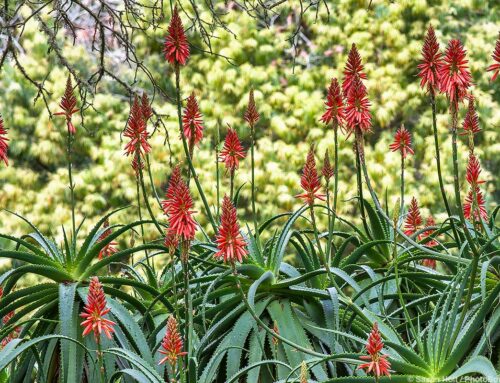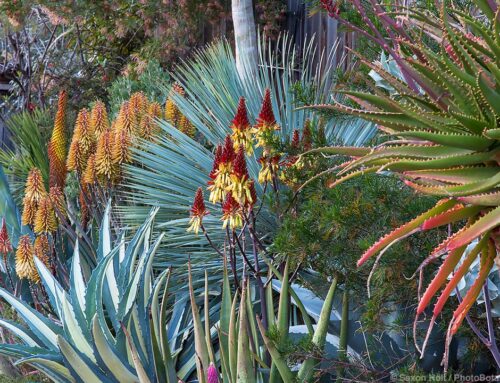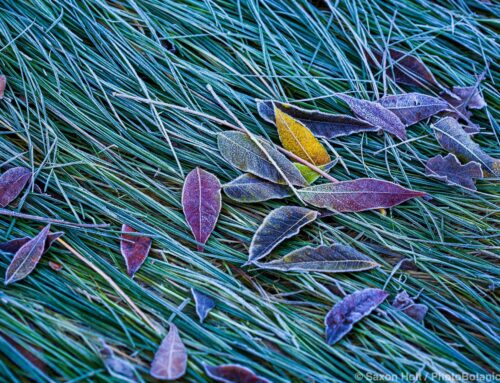Throughout Section Two, we will deal with the tools and concepts that help you compose your image. These are somewhat universal notions for artistic compositions that most photography instruction will cover; here, I’ll illustrate them with garden images.
The camera is a tool that allows you, the garden photographer, to share your love of gardens with others. Think about what that camera will see: usually a distinct and hopefully well-constructed portion of the garden in front of you. These lessons will help you wield your camera so your viewer sees what you want them to see in that garden.
We begin with the notion of framing.
In Section One, I talked about the importance of composition and filling the entire frame of your camera with meaningful information – Composition 101: Fill the Frame. Everything starts with filling the frame, but learning how to fill the frame is the essence of good composition. We’ll begin with the related concepts of forced perspective and juxtaposition of elements.
I use the expression “forced perspective” somewhat differently than in the traditional artistic use (whereby depth is exaggerated by putting large elements close and smaller elements further away). Here in the workshop, a forced perspective is a composition that forces the viewer to see the view, or perspective, that you, the photographer, have seen. To do this, you can usually find physical elements of the garden that you can juxtapose in the composition to help you frame the perspective you want to show. When done well, you can create some intimacy, taking the eye through the garden, keeping it in the frame, and directing it into the special place that is your story.
In the photo above, you are “forced” to see a path leading to the entry of a home. I have framed the photo so that the hedge on the left and the tree in the right are juxtaposed within the framed composition to help tell the story.
These forced perspective and juxtaposition techniques can also work with close-up photos of plants.
In this picture of a yellow pitcher plant (Sarracenia flava), out-of-focus elements help frame the flowers and draw (force) the eye to the focal point (the yellow flowers). It is no accident that I found a bright highlight on the pond beyond to help pull the eye to the story I want to tell.
In one of my framing workshops, I set up a visualization exercise and asked my students to find the framing that would tell a specific story. You can do this yourself anytime you walk into the garden. Stop for a few moments, drink in what you see, and begin to frame up those areas that really speak to you.
Here (above), in the New World Desert Garden at UC Botanical Garden at Berkeley, I really like the gray foliage of Puya that has been used to line the distant path as it turns a corner in the garden. In the wide view of the garden above there is too much going on to expect the viewer to see that story of the Puya, even though the plants are in the center of the image. Moving in closer to fill the frame is obvious (to my eye), but I need to find elements that will direct viewers to the perspective I want them to see. How will I frame it?

It often helps if framing elements that fall in the foreground are out of focus; that pulls the eye into the frame toward the sharpest point, which is often a more intimate view, as in the photo below.
When you find yourself in a good garden, there are likely to be many stories to tell. You will need to slow down and decide to tell one story at a time. Think about what the camera will see—what you can make it see. In a good garden, there will be lots of elements to play with in framing a composition
Here, in landscape architect Gary Ratway’s own garden (above), we find a captivating outdoor room bisected by two axial pathways. How are the physical elements used and composed within the photo?
The paths form quadrants that he accented with matching trees; in the center, he placed a simple container. Think about how this photo was framed and imagine the larger garden that lives beyond. It is not hard to see how this garden was put together.
Notice the white column on the left. Most of the other elements move the eye toward it.
One of Gary’s great talents is in the use of rammed earth to make walls, columns, and structures. In this garden, these white rammed-earth columns announce each entry. Let’s make that the story.
I have put forced perspective and juxtaposition to work in this photo. Note how the juxtaposition of the trees adds depth to the garden view. The right side tree holds the edge of the composition, while the left tree balances the composition so that the column becomes the center of attention. I have consciously juggled these physical elements to be sure that you would see what I saw: the column.
Are you beginning to see how these two concepts help framing? Other elements at work here, such as the narrow diagonal pathway, draw you to the column as the focal point. (I’ll use this same photo in the next lesson, “Focal Points.”)
Often, a slight change in camera position will make a huge difference in perspective as the physical elements move in relationship to each other. I find using a tripod really helps me study how these elements are juxtaposed, changing priorities in the composition and modifying the story. Throughout my workshops, I insist on using a tripod for just this reason. It forces you to analyze the elements of the composition in relationship to each other.
Consider the basic elements of this next garden (fence, patio, urns, and plants), and notice how they are arranged:
In this image, the wooden fence posts announce the entry; the patio beyond is secondary. You want to enter the garden and see the urns, but the story is about entering. The branch obscures a statue—a key element that might otherwise pull you inside.
Now lets rearrange the elements

So, for this lesson, go into the garden, consider all the elements that make up its design, and decide which ones are needed (or not) to tell a story. Then, set up your tripod and compose those elements, juxtaposing them so that they frame your story and force us to see your perspective on the garden.
Supplemental Posts















Leave A Comment